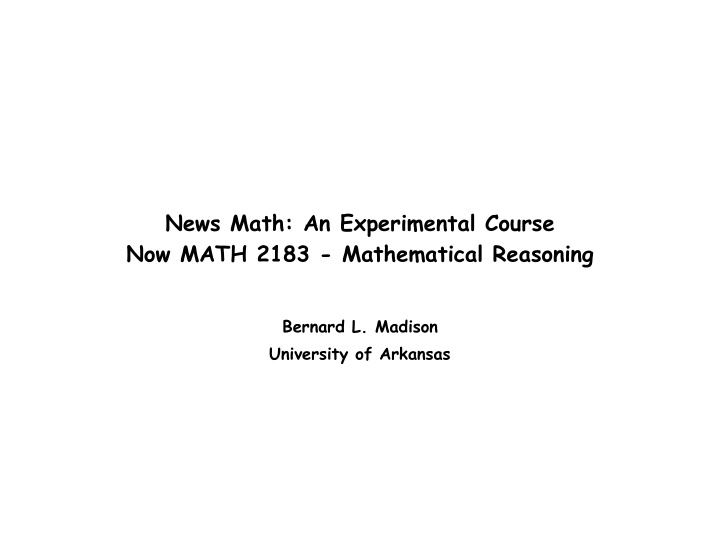



News Math: An Experimental Course Now MATH 2183 - Mathematical Reasoning Bernard L. Madison University of Arkansas
Issues with Traditional Courses • Emphases on components not processes • Lack of mental constructs in lower level courses • Lack of venues for continued practice beyond the course • Not organized like the real world • Tend to degenerate to methods and procedures • Not enough ambiguity • Not enough interpretation and reflection
Changes in Pedagogy • Mathematics should be encountered in many contexts such as political, economic, entertainment, health, historical, and scientific. Teachers will require broader knowledge of many of the contextual areas. • Pedagogy is changed from presenting abstract (finished) mathematics and then applying the mathematics to developing or calling up the mathematics after looking at contextual problems first. • Material is encountered as it is in the real world, unpredictably. Unless students have practice at dealing with quantitative material in this way they are unlikely to develop habits that allow them to understand and use the material. Productive disposition is critical for the students. • Much of the material should be fresh -- recent and relevant.
Changes in Pedagogy • Considerably less mathematics content is covered thoroughly. • The mathematics used and learned is often elementary but the contexts are sophisticated. • Technology – at least graphing calculators with CAS – is used to explore, compute, and visualize. • QL topics must be encountered across the curriculum in a coordinated fashion. If I can coach writing then literature faculty can coach QL. • An interactive classroom is important. Students must engage the material and practice retrieval in multiple contexts.
Information about Students 26 students in fall 2004 40 students in spring 2005 40 students in fall 2005 82 journalism majors 24 others (English, political science, music, social work, etc.) 12 honors students; some athletes; several who had multiple unsuccessful attempts in finite mathematics course 24 freshmen; 13 sophomores; 22 juniors; 47 seniors Hereafter - arts, humanities & education students
Characteristics of the Course • The primary source materials are newspaper and magazine articles that contain quantitative information and analyses - 52 pieces in current course, most published since 2001. • Mathematics (including statistics, without saying it every time) is confronted, developed, and used as it occurs in the articles. The course is not organized by mathematical topics. • Mathematical concepts recur repeatedly, often cloaked in context dependent terminology. • Almost all the problems are ill defined in the sense that assumptions are made that are not specified in the articles. • Graphing calculators are used regularly.
Characteristics of the Course - Continued • Estimation is often the most important lesson of problems. • Most exercises consist of gleaning information from the articles, formulating a mathematics problem, doing the mathematics, and reflecting the results back into the article. • Often, “doing the mathematics” is elementary. • Class sessions are casual and interactive. Students often work on group exercises. Every class begins with a discussion of quantitatively oriented newspaper or magazine articles that students have brought.
Article Sources • Regular articles, editorials, oped pieces, letters to the editor, columns, puzzles, etc. • NY Times, Washington Post, New Yorker, Lincoln (NE) Journal- Star, Arkansas Democrat-Gazette, Morning News of NWA, HortJournal, Better Investing, etc.
Class Activities • News of the day • Group (4’s) class exercises • Mathematical and statistical concepts • Using calculator • Homework • Quizzes • Two exams -- midterm and final
First Version of News Math Titles of Eleven Lessons • Percent • Petty thrift and buying stocks • Condensed measures and indexes • Lower math by Dave Barry • Linear and exponential growth • Measurement • Visual representation of quantitative information • Rates of change • Weather maps and indexes • The odds of that • Risk
Second Version of News Math • Percent and percent change • Linear and exponential growth • Indices • Graphical interpretation and production • Counting • Odds • Risk • Geometric measurement • Weather maps and indexes
Third Version of News Math • Using numbers • Percent and percent change • Linear and exponential growth – Side trip into weighted averages • Indices and condensed measures • Graphical interpretation and production • Counting • Odds • Risk • Geometric measurement • Weather maps, measurements and indices
Fourth Version of News Math AKA Mathematical Reasoning in a Quantitative World • Using numbers • Percent and percent change • Linear and exponential growth – Side trip into weighted averages • Indices and condensed measures • Graphical interpretation and production • Counting • Probability, Odds, & Risk • Weights & geometric measurement • Weather maps, measurements and indices
Recommend
More recommend